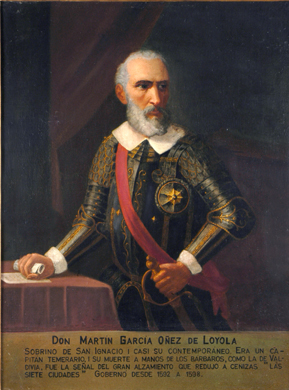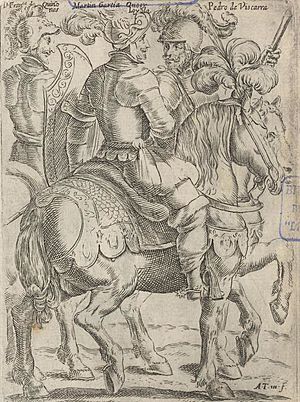Martín García Óñez de Loyola facts for kids
Quick facts for kids
Martín García Óñez de Loyola
|
|
|---|---|
 |
|
| Royal Governor of Chile | |
| In office 1592–1598 |
|
| Monarch | Philip II |
| Preceded by | Pedro de Viscarra de la Barrera |
| Succeeded by | Pedro de Viscarra de la Barrera |
| Personal details | |
| Born | c. 1549 Azpeitia, Gipuzkoa, Spain |
| Died | December 24, 1598 Curalaba, Chile |
| Spouse | Beatriz Clara Coya |
| Military service | |
| Allegiance | |
| Years of service | 1550s–1598 |
| Battles/wars | Arauco War |
Martín García Óñez de Loyola was an important Spanish soldier. He was born in Azpeitia, Spain, around 1549. Later, he became the Royal Governor of Chile. He is known for his role in the Arauco War. This was a long conflict between the Spanish and the Mapuche people in Chile.
Óñez de Loyola was likely the nephew of Ignatius of Loyola. Ignatius was a famous figure who founded the Society of Jesus, also known as the Jesuits.
Contents
Early Life and Achievements
In 1568, when he was a young man, Óñez de Loyola traveled to Peru. He went with the new viceroy, Francisco de Toledo, Count of Oropesa. A viceroy was like a governor who ruled a colony in the name of the king. Martín served as a captain in the viceroy's guard.
In 1572, he took part in a military mission. This mission was against Túpac Amaru, the last leader of the Incas. The Incas were resisting Spanish rule. Óñez de Loyola led a brave attack. His group captured the Inca leader.
For this important success, he was given a special job. He became a corregidor in several towns in Peru. This job gave him control over local goods and labor. He also married Beatriz Clara Coya. She was the daughter of an Inca ruler named Sayri Túpac. Beatriz was also the niece of Túpac Amaru.
Because of his achievements, the king chose him for a new role. In 1592, he was named governor of the Río de la Plata and Paraguay. But before he could start, King Philip II changed his mind. The king believed Óñez de Loyola was the best person to end the Arauco War in Chile. So, he was appointed Royal Governor of Chile instead.
Becoming Governor of Chile
Óñez de Loyola arrived in Chile on September 23, 1592. He was determined to bring peace to the Arauco region. He immediately went to Concepción with 110 soldiers. However, he soon realized that he did not have enough resources. He needed more troops to achieve his goal. So, he asked for help from Peru.
At the same time, a British pirate named Richard Hawkins caused trouble. Hawkins attacked Valparaíso in Chile. He captured a Spanish ship there. Because of this, the authorities in Peru needed their soldiers for their own defense. They could not send the reinforcements Óñez de Loyola had asked for.
Even though he did not get the soldiers, some religious groups arrived. Members of the Jesuit and Augustinian orders came to Chile. The Jesuits, in particular, would become very important later on.
Challenges as Governor
Since he could not wait for more soldiers, Óñez de Loyola started his campaign. In 1594, he led his small group of troops south. He built a fort called Santa Cruz de Óñez in May 1594. This fort was near the Bio-Bio and Laja Rivers. Gold mines were also located nearby. In 1595, the fort became a city and was renamed Santa Cruz de Coya.
Three years later, 140 more soldiers finally arrived. But this was still not enough. It was hard to get people to join the army for Chile. The long and difficult conflict there made people afraid to go. Many saw it as a very dangerous place.
His Final Battle
In 1598, Governor Óñez de Loyola was in La Imperial. He received news that the Mapuche people were attacking Angol again. To help reinforce Angol, he set out with 50 men. This was on December 21, 1598.
On the second day of their journey, they reached a place called Curalaba. It meant "the broken rock." They stopped there to rest by the Lumaco River. However, they did not take enough precautions against an attack. During the nights of December 23rd and 24th, the native Mapuche warriors approached their camp. They attacked the Spanish soldiers with shouts and horns.
Óñez de Loyola and a few soldiers fought bravely. But they were eventually defeated by the Mapuche spears. Almost all the Spanish soldiers died in the fight. Only a priest named Bartolomé Pérez was captured. Another soldier, Bernardo de Pereda, survived with 23 wounds. He was left for dead but miraculously lived.
After this battle, the Mapuches started a big uprising. They destroyed many Spanish cities south of the Biobío River. The Mapuches kept Óñez de Loyola's head. Years later, they returned it to the new governor, Alonso García de Ramón.
See also
 In Spanish: Martín García Óñez de Loyola para niños
In Spanish: Martín García Óñez de Loyola para niños


